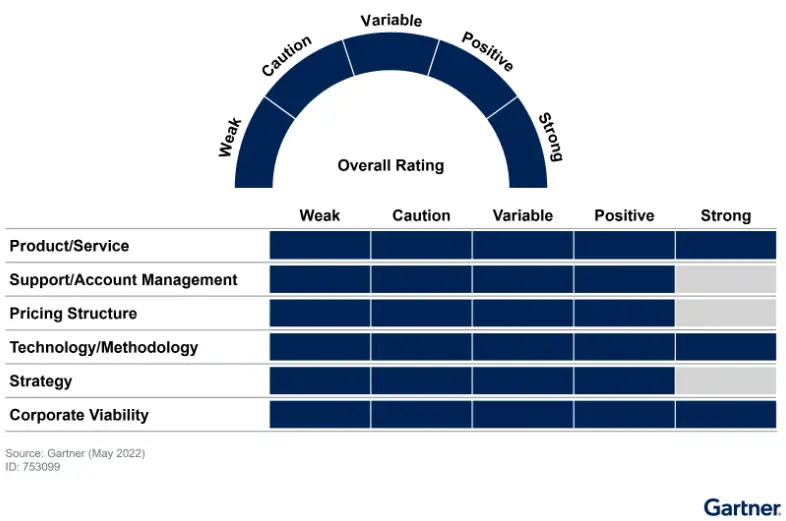Amazon is a high-growth, innovative and technology-driven vendor that continues to disrupt and reshape markets.
Amazon Web Services has grown to become one of the world’s largest cloud providers and exemplifies Amazon’s customer-driven innovation and market disruption.
Overall Rating: strong
Amazon is a multifaceted business consisting of business interests in electronic commerce (e-commerce), cloud computing, digital content development and delivery,
digital advertising, consumer electronics, and retail, as well as extensive logistics resources including fulfillment centers, shipping and delivery. To support its
many business interests, Amazon has developed an immense global supply chain and distribution network. Amazon’s innovative approach to online retail and distribution
made it a critical service for many individuals and organizations through 2021 as the COVID-19 pandemic continued to impact global markets. In response, Amazon invested
in local communities and implemented COVID-19 safety measures throughout its operation to ensure safe working conditions for its employees.

With revenue approaching $470 billion in 2021 and an employee base of 1.6 million, Amazon is one of the world’s largest companies. Amazon Web Services (AWS), Amazon’s cloud computing business, contributed $62.2 billion to Amazon’s top-line revenue, an annual growth rate of 37%. AWS is a critical contributor to Amazon’s overall profitability, accounting for 74% of Amazon’s annual operating income.[1]
Amazon revenue increased more than $80 billion through 2021 with a net operating profitability margin of 5.3%. During the same period, AWS revenue increased $16.8 billion, with operating income growing 27.4%. AWS’s operating profitability margin for the year was 29.8%.[1]
Amazon is an innovation-driven enterprise guided by four key principles: customer obsession, passion for invention, commitment to operational excellence and long-term thinking.[2] Innovative technologies span Amazon’s businesses, with many innovations being packaged and delivered through AWS as cloud service offerings. Amazon uses AWS as a technology foundation to support its e-commerce and digital media businesses, making Amazon a key AWS customer. While Amazon’s e-commerce, retail, advertising and digital media businesses drive revenue growth, AWS drives revenue growth and profitability, enabling Amazon to invest in business initiatives that keep it at the forefront of its respective markets.
Overall, despite the challenges Amazon faces, we rate Amazon as Strong due to its consistent delivery of capabilities and customer value. Amazon’s growth is a reflection of its ability to meet customer needs and adapt to shifting market conditions worldwide. The recent changes in Amazon’s and AWS’s executive leadership will provide Amazon the opportunity to evolve its vision and mission, drawing from both Amazon’s institutional knowledge and external perspective. In July 2021, Andy Jassy became Amazon’s CEO, replacing Amazon founder Jeff Bezos. (Jeff Bezos continues as Amazon executive chair.) Adam Selipsky, previously CEO of Tableau (which was acquired by Salesforce), replaced Andy Jassy as the new AWS CEO in July 2021. Selipsky brings a new, external perspective and vision to the role, including a focus on software, applications and the solutions that AWS can support. Selipsky was part of the AWS leadership team prior to leading Tableau and therefore also has a deep understanding of Amazon and AWS. At AWS’s re:Invent 2021 event, Selipsky outlined a human-centric view of the value of technology and an increased focus on business solutions and value, a noted shift from previous AWS narratives.
As Amazon pursues growth under its new leadership, it must continue to expand its market reach, improve its operational efficiencies, embrace and lead global trends (such as sustainability) and uncover new sources of growth in its cloud business. Amazon’s businesses are facing, and will continue to face, increasing pressure from regulators, activists, labor organizations and competitors, which will continue to challenge Amazon and AWS growth.
Although this document covers the entirety of Amazon, the detailed ratings included in this research primarily focus on Amazon Web Services, unless otherwise noted.
Recommendation for IT leaders:
- Look to Amazon as an archetype for modern, digital business operations by embracing a technology-led approach to delivering business services and optimizing internal operations.
- Accelerate IT modernization by incorporating the dynamic operating models supported by cloud services. The Amazon business model provides an excellent example of using cloud services to support dynamic and adaptive operations.
Recommendations for IT leaders using or considering AWS:
- Consider AWS’s market leadership and its strong portfolio of cloud services and edge capabilities when migrating applications to cloud or modernizing applications and operating processes. AWS has one of the industry’s richest and most mature cloud infrastructure and platform service offerings.
- Embrace cloud-native models by leveraging the advanced capabilities of AWS to support modern applications, including serverless, container-based and service-oriented architectures.
- Amplify the value from your AWS investments through the utilization of AWS platform services. These include cloud database services, data management and analytics, artificial intelligence (AI) and machine learning (ML), distributed cloud and edge computing, the Internet of Things (IoT), and other advanced and innovative platform services.
- Optimize your IT spending on AWS, and maximize your AWS discounts using Saving Plans, Reserved Instances and private pricing agreements.
If you would like to read Gartner’s, Inc. and/or its affiliates full analysis, please click here.
[1] Amazon.com 10-K Securities and Exchange (SEC) filing
(for the fiscal year ended 31 December 2021), U.S. SEC.
[2] Who We Are, Amazon.
